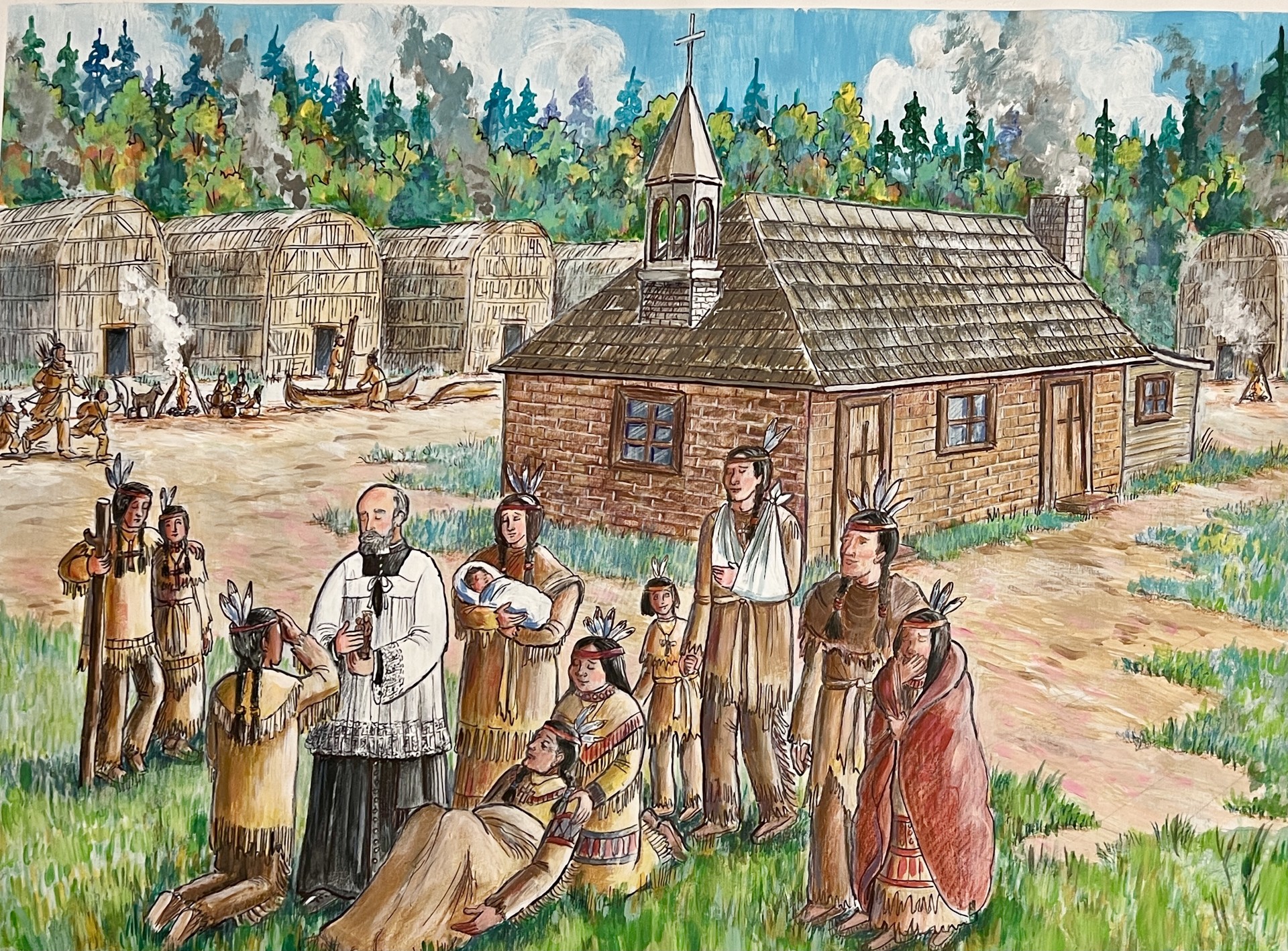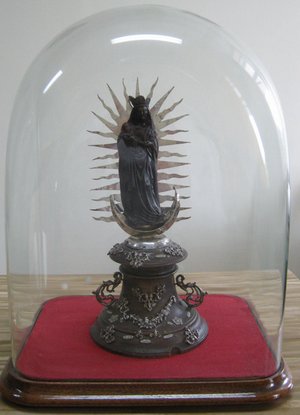The devotion to Notre-Dame-de-Foy in Canada
Discovery of the small statue:
The story begins in 1609, in the town of Foy, Belgium, at the foot of a huge oak tree. That same year, Gilles, a woodcutter from Wanlin, and his companion Innocent Delimoir, while felling an enormous oak 8 feet in diameter, discovered a small statue of the Virgin Mary. Made of terracotta, it was surrounded by a few stones and hair. Gilles and Innocent cried miracle. The story spread to the surrounding area, and a spontaneous cult soon developed. With the discovery of the statue, miracles multiplied and Foy became a place of pilgrimage. The Jesuits began to carve replicas of the statue from the oak in which it had been found.
It was later discovered that the oak was located on the edge of a path used by pilgrims on their way to Saint-Hubert. Some two centuries before the 1609 discovery, one of these pilgrims placed a statue of the Virgin Mary in the hollow of the tree. Over the years, the tree’s bark closed over it and, as the path became less and less frequented, the statue’s existence was forgotten.
A shrine:
At first, the statue was placed in another oak tree, but the Baron de Celles, having noticed that attempts had been made to steal it, moved it to his oratory in the Château de Vêves (barony of Celles). Visitors and pilgrims began to flock to the site.
A first miracle took place in 1616: following the Virgin Mary’s intercession, an old man was cured of a painful and debilitating hernia. The Bishop of Liège, Ferdinand de Bavière, conducted a canonical inquiry and declared the miracle authentic.
In 1618, the influx of pilgrims – and the publicity given to the site by the visit of Archdukes Albert and Isabelle in 1619 – led to the construction of a larger chapel. Work began in 1622. The plans were drawn up by brothers Michel and Jaspard Stilmant with the help of Guillaume Goblet. However, in the 19th century, historians attributed the work to B. Flémalle and an unknown Bartholomé.
Devotion to Canada:
Throughout the 17th century, the sanctuary enjoyed extraordinary renown. Pilgrims came from everywhere. Veneration of Notre-Dame de Foy spread outside the country, especially by missionaries who went overseas. Replicas of the miraculous statue were made and spread around the world.
In Canada, the first missionary to bring back replicas of Notre-Dame-de-Foy was the Jesuit missionary Pierre Chaumonot. He brought back his first statue in 1680, to help evangelize the Hurons. Today, it is kept at Notre-Dame-de-Lorette church in Wendake, near Quebec City.

The statue at the Servantes de Jésus-Marie :
The small statue of Notre-Dame-de-Foy carefully preserved under a glass bell by the Servantes de Jésus-Marie has had a different, but just as unique, journey as that of the Jesuit Chaumonot. The one we have has long been passed down through the family of our founder, Father Alexis-Louis Mangin,” explains the congregation’s Mother Servant General, Sister Marie-du-Bon-Pasteur. He received it from his father before he left France for Canada in 1885. It’s a very rare object that has great spiritual value for us.
The small statue has been dated by the Ville de Gatineau to around 1780, but it could well be even older. According to Sister Marie-du-Bon-Pasteur, their statue is authentic and comes from the oak tree in which the original statue was found. In his diaries, Father Mangin explains how she was able to save her family and several Catholic priests from certain death during the French Revolution.
This statue of Notre-Dame-de-Foy is miraculous and has worked many wonders,” wrote Father Mangin. In 1793, during the great revolution, it protected my family and my grandfather’s house, when he was not afraid to expose himself daily to the peril of death, hiding priests who were being pursued and having Holy Mass celebrated, by night, in his cellar or attic; and all this in the midst of a town very agitated by revolutionary ideas and under the continual surveillance of informers and soldiers of the Revolution.”
Miracles in the Outaouais region :
The statue of Notre-Dame-de-Foy is said to have protective virtues against fires, says Sister Marie-du-Bon-Pasteur, superior of the Servantes de Jésus-Marie. “It has helped us fight fires on several occasions,” she says. The story of the Servantes de Jésus-Marie goes that Fat Mangin invoked Notre-Dame-de-Foy the first time, in the early days of the congregation, to put out a fast-growing fire in the roof of the first small convent in Masson. A single bucket of water thrown by Father Mangin brought the fire under complete control. Another fire in the sacristy of the Laurier Street monastery in 1905 was also extinguished with a single bucket of water.
Sources:
-Mathieu BÉLANGER, Le Droit, Le trésor patrimonial des Servantes de Jésus-Marie.
-www.ledroit.com/ma-region/le-tresor-des-soeurs-a7be600cf564934df1987f3cdd344155








